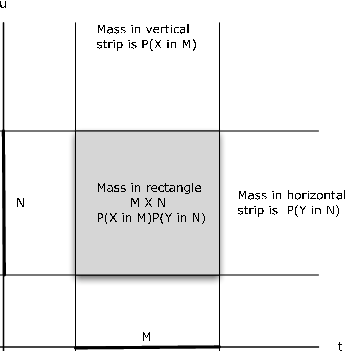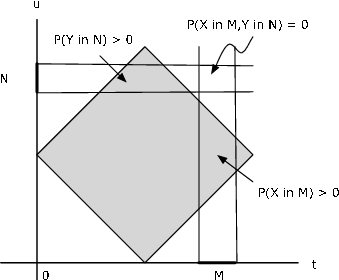| << Chapter < Page | Chapter >> Page > |
It should be apparent that the independence condition puts restrictions on the character of the joint mass distribution on the plane. In order to describe this more succinctly,we employ the following terminology.
Definition
If M is a subset of the horizontal axis and N is a subset of the vertical axis, then the cartesian product is the (generalized) rectangle consisting of those points on the plane such that and .
The rectangle in [link] is the Cartesian product , consisting of all those points such that and (i.e., and ).

We restate the product rule for independence in terms of cartesian product sets.
Reference to [link] illustrates the basic pattern. If M , N are intervals on the horizontal and vertical axes, respectively, then the rectangle is the intersection of the vertical strip meeting the horizontal axis in M with the horizontal strip meeting the vertical axis in N . The probability is the portion of the joint probability mass in the vertical strip; the probability is the part of the joint probability in the horizontal strip. The probability in the rectangle is the product of these marginal probabilities.
This suggests a useful test for nonindependence which we call the rectangle test . We illustrate with a simple example.

Supose probability mass is uniformly distributed over the square with vertices at (1,0), (2,1), (1,2), (0,1). It is evident from [link] that a value of X determines the possible values of Y and vice versa, so that we would not expect independence of the pair. To establish this, consider the small rectangle shown on the figure. There is no probability mass in the region. Yet and , so that
, but . The product rule fails; hence the pair cannot be stochastically independent.
Remark . There are nonindependent cases for which this test does not work. And it does not provide a test for independence. In spite of these limitations, it is frequently useful.Because of the information contained in the independence condition, in many cases the complete joint and marginal distributions may be obtained with appropriate partialinformation. The following is a simple example.
Suppose the pair is independent and each has three possible values. The following four items of information are available.
These values are shown in bold type on [link] . A combination of the product rule and the fact that the total probability mass is one are used to calculate each ofthe marginal and joint probabilities. For example and
implies . Then
. Others are calculated similarly. There is no unique procedure for solution. And it has not seemeduseful to develop MATLAB procedures to accomplish this.

Notification Switch
Would you like to follow the 'Applied probability' conversation and receive update notifications?